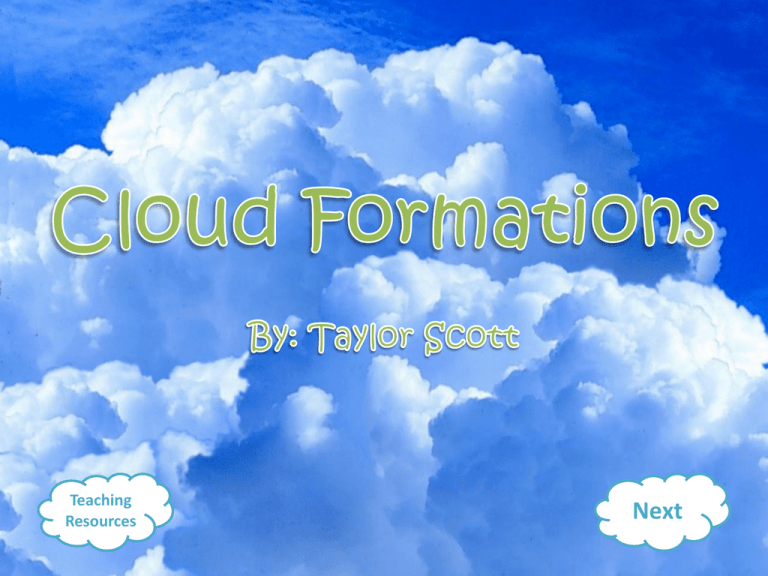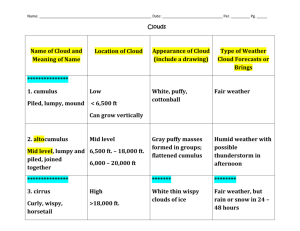Types of Clouds
advertisement

Teaching Resources Next Audience Objective Environment Back Next •3rd grade •Average to Above Average Students •Suburban Class •A lesson during class computer time Back •Individually •At a computer that has headphones •Quiet Back Given information on the three main types of clouds, students will be able to recognize and recall the name when shown a picture and correctly answer the questions at the end of the lesson with a 5/5. Back Back Next Start Lesson OR Next 1. Water droplets form in the air 2. These droplets combine with particles of dust 3. Enough droplets combine together to form a cloud Back to Options Next • Normally, the air can hold up the water droplets weight, but sometimes the droplets are too heavy and the air can’t support it anymore, so the droplets fall Fun Fact: It takes about 1 million drops to form an average sized raindrop Back Next Thunderstorms need three things: 1. Moisture 2. Warm air (unstable air) 3. High air (lift) If you here thunder, get to a safe place immediately! Back Next Back to Options Next • • • • Thin Wispy Bunched together White to light gray Back Next • • • Highest of the three main cloud types Doesn’t produce rain or storms Although it doesn’t produce rain, it can form into thunderstorms or cyclones when combined with other factors Back Next Back Next Cirrus Clouds produce rain and storms by themselves. That is Correct! Cirrus clouds cannot produce rain, but it is possible when they are combined with other factors. Back Next I’m sorry, that is incorrect. Cirrus clouds cannot produce rain, but it is possible when they are combined with other factors. Back Next Back to Options Next • • • • Defined edges Puffy Cotton-like White or off white Back Next • • Middle of the three cloud types (in height) Produces rain, hail and tornadoes Back Next Back Next Cumulus Clouds are puffy and cotton like. That is Correct! Cumulus Clouds are puffy and cotton like. Back Next I’m sorry, that is incorrect. Cumulus Clouds are puffy and cotton like. Back Next Back to Options Next • • • • Flat Hazy Light to dark gray “Cloudy day” clouds Back Next • • • Lowest of the three cloud types (in height) Creates Fog Can create light drizzle or snow Back Next Back Next Stratus Clouds produce fog. That is Correct! Stratus Clouds create fog. Back Next I’m sorry, that is incorrect. Stratus Clouds create fog. Back Next Time for the quiz! Back to Options Next 1. Which type of cloud is most likely to produce rain? That is Correct! Cumulus clouds produce rain and sometimes thunderstorms! Back Next I’m sorry, that is incorrect. Review • • • • Defined edges Puffy Cotton-like White or off white Next • • Middle of the three cloud types (in height) Produces rain, hail and tornadoes Now.. Try question again 2. What type of cloud looks wispy and thin? That is Correct! Cirrus clouds are wispy and thin. Back Next I’m sorry, that is incorrect. Review • • • • Thin Wispy Bunched together White to light gray Next • • • Highest of the three main cloud types Doesn’t produce rain or storms Although it doesn’t produce rain, it can form into thunderstorms or cyclones Now.. Try question again 3. Which cloud type produces fog? That is Correct! Stratus clouds create fog. Back Next I’m sorry, that is incorrect. Review • • • • Flat Hazy Light to dark gray “Cloudy day” clouds Next • • • • Lowest of the three cloud types (in height) Creates Fog Can create light drizzle or snow Now… Try Question Again 4. What two things are combined to form a cloud? That is Correct! Water and dust form clouds. Back Next I’m sorry, that is incorrect. Review 1. Water droplets form in the air 2. These droplets combine with particles of dust 3. Enough droplets combine together to form a cloud Now… Try Question Again 5. Choose the tings that are needed for a thunderstorm to form. A) Moisture B) Cold Air C) Warm Air D)High Air E) Low Air That is Correct! Moisture, warm air and high are needed for a thunder storm Back Next I’m sorry, that is incorrect. Review Thunderstorms need three things: 1. Moisture 2. Warm air (unstable air) 3. High air (lift) If you here thunder, get to a safe place immediately! Now… Try Question Again CONGRATULATIONS! YOU HAVE COMPLETED THE LESSON! End Lesson Start Lesson Over







